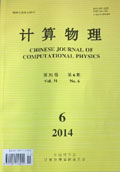|
|
Three-Dimensional Time-Domain Electromagnetic Inverse Scattering Technique for Debye Dispersive Media
LIU Guangdong, YU Guangqun, FAN Shimin
2015, 32(4):
455-468.
Dielectric properties of a variety of media,such as biological tissues,soil,and water,are frequency-dependent,which are depicted frequently by a single-pole Debye model. A three-dimensional (3-D) time-domain electromagnetic inverse scattering technique,based on functional analysis and variation method,is developed to reconstruct dispersive properties of media. Main procedures of the technique are: ① Inverse scattering problem is turned into a constrained minimization problem,according to the least squares criterion; ② Resulting problem is translated into an unconstrained minimization one,using a penalty function method;③ Closed Fréchet derivatives of Lagrange function with respect to properties are derived,based on calculus of variations; ④ Resulting problem is solved with any gradient-based algorithm. Furthermore,a first-order Tikhonov's regularization is adopted to cope with noise and ill-posedness of the problem. In numerical experiment,the technique is applied to a simple 3-D cancerous breast model,with Polak-Ribière-Polyak conjugate gradient algorithm and finite-difference time-domain method. Simulated results demonstrate preliminarily feasibility,effectiveness and robustness of the method.
|
